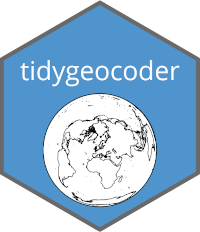Introducing Tidygeocoder 1.0.0
Filed under:
Tidygeocoder v1.0.0 is now live on CRAN. There are numerous new features and improvements such as batch geocoding (submitting multiple addresses per query), returning full results from geocoder services (not just latitude and longitude), address component arguments (city, country, etc.), query customization, and reduced package dependencies.
For a full list of new features and improvements refer to the release page on Github. For usage examples you can reference the Getting Started vignette.

To demonstrate a few of the new capabilities of this package, I decided to make a map of the stadiums for the UEFA Champions League Round of 16 clubs. To start, I looked up the addresses for the stadiums and put them in a dataframe.
library(dplyr)
library(tidygeocoder)
library(ggplot2)
require(maps)
library(ggrepel)
# https://www.uefa.com/uefachampionsleague/clubs/
stadiums <- tibble::tribble(
~Club, ~Street, ~City, ~Country,
"Barcelona", "Camp Nou", "Barcelona", "Spain",
"Bayern Munich", "Allianz Arena", "Munich", "Germany",
"Chelsea", "Stamford Bridge", "London", "UK",
"Borussia Dortmund", "Signal Iduna Park", "Dortmund", "Germany",
"Juventus", "Allianz Stadium", "Turin", "Italy",
"Liverpool", "Anfield", "Liverpool", "UK",
"Olympique Lyonnais", "Groupama Stadium", "Lyon", "France",
"Man. City", "Etihad Stadium", "Manchester", "UK",
"Napoli", "San Paolo Stadium", "Naples", "Italy",
"Real Madrid", "Santiago Bernabéu Stadium", "Madrid", "Spain",
"Tottenham", "Tottenham Hotspur Stadium", "London", "UK",
"Valencia", "Av. de Suècia, s/n, 46010", "Valencia", "Spain",
"Atalanta", "Gewiss Stadium", "Bergamo", "Italy",
"Atlético Madrid", "Estadio Metropolitano", "Madrid", "Spain",
"RB Leipzig", "Red Bull Arena", "Leipzig", "Germany",
"PSG", "Le Parc des Princes", "Paris", "France"
)
To geocode these addresses, you can use the geocode function as shown below. New in v1.0.0, the street, city, and country arguments specify the address. The Nominatim (OSM) geocoder is selected with the method argument. Additionally, the full_results and custom_query arguments (also new in v1.0.0) are used to return the full geocoder results and set Nominatim’s “extratags” parameter which returns extra columns.
stadium_locations <- stadiums %>%
geocode(street = Street, city = City, country = Country, method = 'osm',
full_results = TRUE, custom_query= list(extratags = 1))
This returns 40 columns including the longitude and latitude. A few of the columns returned due to the extratags argument are shown below.
stadium_locations %>%
select(Club, City, Country, extratags.sport, extratags.capacity, extratags.operator, extratags.wikipedia) %>%
rename_with(~gsub('extratags.', '', .)) %>%
knitr::kable()
| Club | City | Country | sport | capacity | operator | wikipedia |
|---|---|---|---|---|---|---|
| Barcelona | Barcelona | Spain | soccer | NA | NA | en:Camp Nou |
| Bayern Munich | Munich | Germany | soccer | 75021 | NA | de:Allianz Arena |
| Chelsea | London | UK | soccer | 41837 | Chelsea Football Club | en:Stamford Bridge (stadium) |
| Borussia Dortmund | Dortmund | Germany | soccer | NA | NA | de:Signal Iduna Park |
| Juventus | Turin | Italy | soccer | NA | NA | it:Allianz Stadium (Torino) |
| Liverpool | Liverpool | UK | soccer | 54074 | Liverpool Football Club | en:Anfield |
| Olympique Lyonnais | Lyon | France | soccer | 58000 | Olympique Lyonnais | fr:Parc Olympique lyonnais |
| Man. City | Manchester | UK | soccer | NA | Manchester City Football Club | en:City of Manchester Stadium |
| Napoli | Naples | Italy | soccer | NA | NA | en:Stadio San Paolo |
| Real Madrid | Madrid | Spain | soccer | 85454 | NA | es:Estadio Santiago Bernabéu |
| Tottenham | London | UK | soccer;american_football | 62062 | Tottenham Hotspur | en:Tottenham Hotspur Stadium |
| Valencia | Valencia | Spain | NA | NA | NA | NA |
| Atalanta | Bergamo | Italy | soccer | NA | NA | NA |
| Atlético Madrid | Madrid | Spain | soccer | NA | NA | es:Estadio Metropolitano (Madrid) |
| RB Leipzig | Leipzig | Germany | NA | NA | NA | de:Red Bull Arena (Leipzig) |
| PSG | Paris | France | soccer | 48527 | Paris Saint-Germain | fr:Parc des Princes |
Below, the stadium locations are plotted on a map of Europe using the longitude and latitude coordinates and ggplot.
ggplot(stadium_locations, aes(x = long, y = lat)) +
borders("world", xlim = c(-10, 10), ylim = c(40, 55)) +
geom_label_repel(aes(label = Club), force = 2, segment.alpha = 0) +
geom_point() +
theme_void()

Alternatively, an interactive map can be created with the leaflet library:
library(leaflet)
stadium_locations %>% # Our dataset
leaflet(width = "100%", options = leafletOptions(attributionControl = FALSE)) %>%
setView(lng = mean(stadium_locations$long), lat = mean(stadium_locations$lat), zoom = 5) %>%
# Map Backgrounds
addProviderTiles(providers$Stamen.Terrain, group = "Terrain") %>%
addProviderTiles(providers$NASAGIBS.ViirsEarthAtNight2012, group = "Night") %>%
addProviderTiles(providers$Stamen.Toner, group = "Stamen") %>%
addTiles(group = "OSM") %>%
# Add Markers
addMarkers(
labelOptions = labelOptions(noHide = F), lng = ~long, lat = ~lat,
clusterOptions = markerClusterOptions(maxClusterRadius = 10), label = ~Club,
group = "Stadiums"
) %>%
# Map Control Options
addLayersControl(
baseGroups = c("OSM", "Stamen", "Terrain", "Night"),
overlayGroups = c("Stadiums"),
options = layersControlOptions(collapsed = TRUE)
)
If you find any issues with the package or have ideas on how to improve it, feel free to file an issue on Github. For reference, the R Markdown file that generated this blog post can be found here.